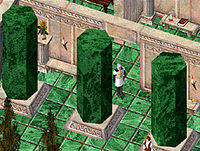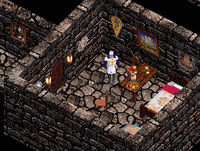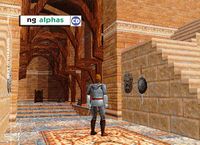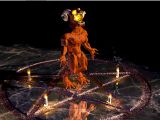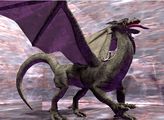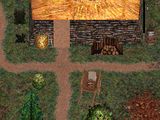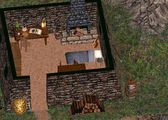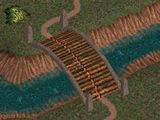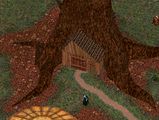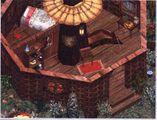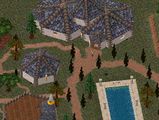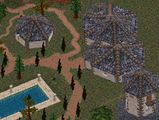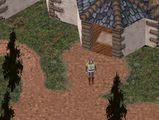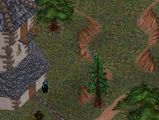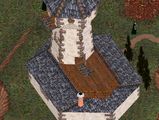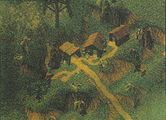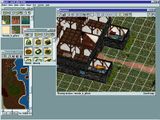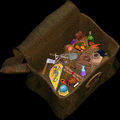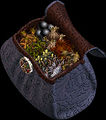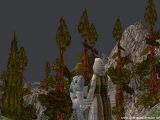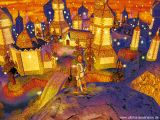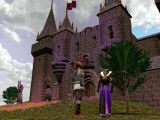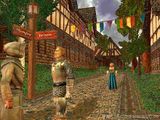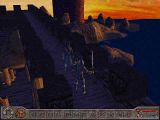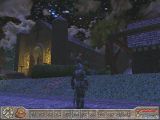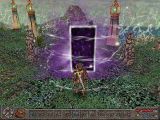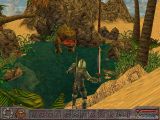Development history of Ultima IX

The development history of Ultima IX: Ascension spans the years 1994–1999, and is generally categorized by the four distinct iterations through which the title evolved before its final release. These alterations to the course of the game's creation were brought about by a series of events that catalyzed significant changes to its engine and plot, including the sudden prioritization of Ultima Online and a tumultuous senior personnel upheaval that heralded the final eighteen months of development.
Pre-production and Crusader Engine (1991–1994)[edit]
Unlike its later iterations, there are relatively few known details of the initial conceptual outline for Ultima IX, and no prototypes from its first phase of active development have been publicly unveiled. During work on Ultima VII, series creator Richard Garriott had already planned for Ultima IX to conclude the saga of the Avatar,[1] whereby the player character would, in some fashion, die to destroy the Guardian.[2] The game's earliest public mention appears in Caroline Spector's 1992 interview with Garriott (conducted for Ultima: The Avatar Adventures prior to the release of Ultima VII), in which he indicates it would take place in Britannia.[3] In early 1993, while Ultima VIII was under development, Garriott spoke of his intention to ship its sequel in a white, cloud-covered box with a glassy logo, completing the trilogy's minimalist theme established by the stark black packaging of Ultima VII and blazing orange cover art for Ultima VIII (each so designed to form a "wall of color" when displayed on store shelves).[4][5] It was also during this period that the game's full title began to be publicized.
In its incipient form, the story of Ultima IX was to follow directly from Pagan and chronicle the Avatar's ascension to immortality as the Titan of Ether, such that the Guardian might finally be vanquished. While Garriott had come to envision this unfolding on the conqueror's own homeworld (also foreshadowed in the official Ultima VIII clue book, Pentology[6]), the series finale was slated to return to a ravaged Britannia by the time its predecessor's closing sequence was finalized.[7][2] Another early proposal for Ascension’s climax included the revelation of the Guardian and Avatar as correlative entities, with Lord British personally joining his champion in the final campaign to eradicate the red conqueror. Deadlocked in a cataclysmic battle and faced with the prospect of Britannia's collateral destruction, the player (as the Avatar) would have been forced to accept a fatal blow from the Guardian, in turn causing the villain's own demise. In this version of events, however, Britannia's king would have then resurrected the fallen Avatar, reverting the hero to an ordinary, powerless mortal and thus bringing the entire series full circle.[8]
The game's earliest design sought to expand upon the Avatar's capacity to jump and climb in Pagan by allowing for other such abilities as swimming, crawling, and swinging.[9] With Ultima VIII eliciting a significant number of customer complaints, however, Origin wished to amend the series' direction by reprising the design formulae of Ultima IV to Ultima VII and Serpent Isle, while instructed by parent company Electronic Arts to reestablish the franchise regardless of production time.[10][11] In the FANS.TXT file included with the final patch for Ultima VIII, Garriott would later write, "The design of Ultima IX (which is still in progress) relies heavily on this feedback and has resulted in a dramatic turnaround back toward classic role playing. Even better, it has resulted in a classic Britannian Ultima."
The Ultima creator also spoke to this effect when interviewed by Julian Schoffel in 1994:[12]
- "To my mind there really were some issues with Ultima VIII that I do want to address in Ultima IX. For example when you point to where you want to jump in Ultima IX, he jumps to exactly that location. You will have a set of attributes, like strength and dexterity that dictate how far and how accurately he (the Avatar) can jump. That gets it out of the ‘arcadey-ness’ that was probably an accurate criticism of Ultima VIII and puts it back into what it was really meant to be: a role-playing game."
- "What I am about to tell you is literally days old. In Ultima IX it's the end of the Guardian, not only that but it's also the end of this whole Avatar business we've been going on about, so Ultima IX is actually the conclusion of Ultimas I through to IX. Ultima X will be a completely fresh start and probably won't even be called Ultima X."
- "In many ways Ultima IX tears down the Avatar philosophy. After going through the gate at the end of Ultima VIII you are in fact back in Britannia, obviously things have changed significantly while you were away and you eventually discover that you and the Guardian are cosmically related. Don't forget that this is the end of Ultima as we know it, so something very profound happens at the end of Ultima IX..."
As most of the Ultima VIII development team had transitioned to Origin's sci-fi action game, Crusader: No Remorse, Ascension began production with the few who remained: director and lead programmer Mike McShaffry; artist Denis Loubet; and writer-designer John Watson.[8] Programmer Jason Ely was also an early participant in the design process, but soon elected to join his other colleagues on Crusader.[13] Initially developed in parallel under producer Warren Spector, the two games shared a close working relationship between their respective teams (which were intended to merge upon the release of Crusader[10]) as well as a common codebase. This engine was itself a refined and enhanced derivative of Ultima VIII's, counting a 640×480 Super VGA display resolution among its improvements,[7][13] and would continue to be iterated upon for Ultima IX until its eventual release.[14] Throughout this period, the ninth chapter in the series featured a world layout akin to Ultima IV and Ultima V, reviving their dual-scale map systems to distinguish the broadly ranged overworld from more intimately explorable cities and dungeons.[7][15] Character portraits were also set to return.[9]
After several months on this trajectory, by late 1994 the Ultima IX team desired to expand the project's scope beyond the capabilities of its current engine and, with Garriott taking a more influential role in proceedings as creative director, its form was to be fundamentally overhauled.[8][15][16]
Bob White and Isometric 3-D (1995–1997)[edit]
While the setting remained a Britannia invaded by the Guardian during the Avatar's absence, the first draft of a comprehensive plot treatment, in which the columns appear and a populace on the brink of civil war must be united against their conqueror, was collaborated upon by Garriott, Watson, and Brian Martin, the three of whom had previously worked together designing Ultima VII and Ultima VIII. This script was considered to be approaching completion in February 1995, and efforts to build the development team began in earnest.[17] In a bid to lend momentum to the game's new direction, Garriott invited his childhood friend and fellow Dungeons & Dragons enthusiast, Bob White, to join the design team in April.[18][19] White, himself an Ultima fan, assisted the trio of writers with revisions and polishing along with Chuck Zoch,[20] and the story was tested in advance of implementation by members of the group playing it through as a tabletop role-playing game.[21]
The prototypical bitmapped graphics engine of Ultima IX also received a major alteration, courtesy of programmer Gary Scott Smith, to instead display software-rendered, three-dimensional polygons.[16][14] With its camera locked in an overhead viewpoint, the game world – four times the size of Ultima VII and comprised of 256×256 screens[22] – was displayed via parallel projection. In addition to preserving the isometric view of Ultima VIII, bypassing true perspective calculation in a 3D environment was also less computationally taxing and therefore allowed for a smoother frame rate.[23] Unlike its predecessors, however, the camera could be freely rotated about its vertical axis and zoomed in or out (much like another Electronic Arts game of the era, Syndicate Wars); while it was at the behest of Garriott that the design of Ascension return to the seamless, single-scale world previously seen in Ultima VI and Ultima VII,[8][24] he nevertheless indicated this variable zoom level could simulate multiple scales for conversations, towns, and wilderness travel.[25]
The revised game allowed for a party system and pre-rendered cutscenes, as well as a skill system through which the player could cultivate proficiency – and certain niches of specialty – in up to twenty abilities, such as magic and swordplay.[23] A choice of gender for the Avatar was also accounted for.[26][27] Although the plot treatment called for various companions to accompany the hero, this could be problematic at times, as the engine's performance was found to struggle when rendering multiple on-screen characters.[8] Combat was described as "interventionist", whereby real-time action would pause for party members to be issued with commands; this allowed a degree of flexibility as to the player's preference for turn-based or real-time combat.[28]
Garriott had marginally revised his previous box art design by early 1996, and now planned for Ascension’s cover to depict a blue, lightly clouded sky.[25] At this time, the first glimpses of concept sketches and preliminary cutscenes for Ultima IX began to surface through various magazines;[29] in the following months, screenshots of the gameplay itself became public, with Garriott previewing the title to the gaming press in May at the Electronic Entertainment Expo (E3), as well as Origin's own offices. Now in full production, the development team had grown to approximately thirty people.[11]
It was considered for a time to port the game to the Sony PlayStation console, with several Sony-related magazines even featuring previews.
By September, dialogue recording sessions for major characters were completed at Magnolia Studios in Burbank, California. The cast included Kay Kuter as Lord British, Keith Szarabajka as the Avatar, Clive Revill as Iolo, Maurice LaMarche as Shamino, Cree Summer as Raven, Scott Bullock as Samhayne, Scott Cleverdon as Lord Blackthorn, and Michael Dorn as the Guardian.[30] Owing to later recasting, none of these performances would appear in the final release.
Ultima IX had progressed on schedule to a relatively advanced state before Ultima Online drew an unexpectedly popular response to its public alpha test. Seizing upon this burgeoning opportunity with an influx of extra resources to hasten its completion, Electronic Arts had Origin transfer the entire Ascension team to the groundbreaking MMORPG, beginning with some members by October 1996 and culminating in December.[31][10][22] The cardinal Ultima was on the verge of its own alpha phase at this time, with the world map approximately 80% complete – albeit in need of fine-tuning – and many fundamental game systems, such as conversations, plot scripting, inventory, object interaction, and combat, either fully implemented or in the process thereof.[16] Nevertheless, the newly integrated team was able to push Ultima Online to release less than nine months later; Ultima IX was largely neglected throughout this effort as a consequence, and with tensions over the reassignment mounting, it eventuated that many of its original team members did not return to the project, were fired, or resigned from Origin.[8][10][16][32]
By mid-1997, the game had been effectively canceled, lacking both a functioning team and corporate support from Electronic Arts.[14][10] During the shift to Ultima Online, however, McShaffry secretly experimented at his home with porting Ultima IX to 3dfx Interactive's hardware-accelerated Glide API and, upon a demonstration of the fourfold increase in performance this facilitated, Origin was inspired to resume with an exclusively hardware-rendered engine.[10][14][33]
Ed Del Castillo's Ultima: Ascension (1997–1998)[edit]
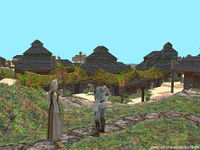
The conversion to Glide opened avenues for experimentation with new camera angles, and a trailing third-person point of view was settled upon to foster a more immersive gaming experience. While many at Origin were excited by this, several team members, including lead designer Bob White, lobbied unsuccessfully to retain the bird's-eye perspective used previously, fearing contemporary computing power would not be sufficient to viably accommodate the game's demanding new form.[16]
On the heels of this development, it was decided McShaffry would not continue with the project, and Westwood Studios programmer Bill Randolph was hired to oversee coding responsibilities in his stead. Upon joining, Randolph recommended his former Westwood colleague, designer Ed Del Castillo (Command & Conquer) be appointed as the project's producer, and the rest of the team was rebuilt with new hires. Electronic Arts encouraged this renewed crew to do their utmost to deliver an exceptional finale to the series, for which they planned accordingly.[14]
Unable to overcome technical challenges with performance and pathfinding for non-player characters (NPCs), it was resolved to omit the party system from the game and instead reprise the solitary experience of Ultima VIII. To compensate for this, it was intended to provide the player with opportunities to take control of other characters as required, such as Shamino, Raven, and even Lord British; this gameplay mechanic was also ultimately scrapped, however, out of concern it could disorient the player.[14] Space requirements demanded by the game's voice acting and pre-rendered cutscenes also necessitated the female Avatar option not be realized.[34]
For a time, there was pressure from Origin's marketing department and Electronic Arts executives to implement multiplayer support, which was flatly rejected by Garriott and Del Castillo.[14]
The story of the game was amended further by Del Castillo but remained largely similar to its previous version, albeit with modifications to accommodate the lack of a party and the short-lived ability to inhabit other characters. Perhaps the most significant change came to the plot's penultimate moments, which forwent Britannia's immolation by way of a desperate casting of Armageddon – present throughout White's revisions – in favor of a conclusion resembling the first and final iterations of the storyline, in which the Avatar instead destroys the Guardian through self-sacrifice.
February 1998 saw the first previews of the game's new visuals appear to the public, as well as a simplified title: Ultima: Ascension. In the following months, statements given by Del Castillo indicated a shift in emphasis toward action-oriented gameplay and visual impact, seemingly at odds with the return to classic Ultima hallmarks championed in previous years. Substantiating this in late April was the sudden and vocal departure from Origin of two Ascension designers, Marshall Andrews and Dan Rubenfield, who alleged and denounced a conscious move by the company to abandon Ultima traditions in favor of garnering mass market appeal and profit;[35] Garriott countered this in response, claiming rather the duo's resignations eventuated from their reluctance to adopt his design ethic.[36] Three weeks later, lead designer White followed Rubenfield and Andrews to Ion Storm, albeit on more amicable terms.[37] White would later corroborate the account given by his two colleagues, in 2011 recalling corporate influence to steer the series toward a reductive, console-oriented format.[38]
Upon the game's first public demonstration at E3 1998 in late May, suggestions of an increasingly mainstream focus continued to be fueled by various reports from the show floor, as well as a modernized teaser trailer – predominantly a showcase of special effects and frenetic combat scenes set to heavy metal music – briefly made available by Origin during the event. Furthermore, this trailer and other promotional materials debuted a logo radically different from previous installments, and an official press release rebranded the title as "an action-adventure game set in the Ultima universe." Concerns over this dramatic change of direction were expressed to the point that Del Castillo was moved to appeal for the fanbase's support.[37]
The unfolding controversy ultimately came to a head in July when Del Castillo, already a contentious figure at Origin, was asked to resign over what was publicly attributed to philosophical differences.[39][14] Garriott would later clarify that he felt Del Castillo, although a capable designer, lacked a deeper understanding of the Ultima series required to deliver a worthy entry.[36]
Final Release (1998–1999)[edit]
Facing a leadership vacuum, Garriott once again took charge of development himself and, of symbolic note, the numerical IX suffix was restored to the game's official title. With remaining designer Seth Mendelsohn promoted to the vacant lead position, he and Garriott embarked on an extensive rewrite of Ultima IX's storyline, simplifying its scope and shifting the primary focus toward a new narrative whereby the Avatar would be tasked with restoring the desecrated Virtues. Although elements of the former plot survived in various forms, several major themes such as the threat of civil war and the Guardian's fomentation of disunity between Lord British and the Avatar were removed from the game entirely, as was a climactic, large-scale battle pitting Britannia's armed forces against her would-be conqueror's. Furthermore, Garriott called for the downsizing of Britannia's surface area to ease world-building and playability.[40]. A number of new cinematic sequences required to account for this overhaul were outsourced to Blur Studio; however, some legacy assets created for earlier drafts of the plot were instead made to cohere with its new revision, such that certain characters, gameplay areas, and cutscenes in the final product appear in contexts for which they were not originally intended. To keep up with all the revisions to the plot, Origin hired Hollywood screenwriter Kim Krizan to rewrite and polish NPC dialogues.[41] As Krizan is uncredited in the credits, it is unknown what, if any, of her work remains in the final game.
Following this change of direction, another major code rewrite was undertaken throughout the latter half of 1998, remaining markedly defective when the build was due for a progress demonstration at Electronic Arts' California headquarters in November.[42] Balking at its lackluster performance, the corporation issued an immediate cancellation before being persuaded by Garriott to relent.[14] Nevertheless, while having previously pledged its full backing to ensure the greatest possible result, Electronic Arts significantly reduced the troubled project's budget and available resources, and, eager to prioritize work on Ultima Online 2, mandated a release by Christmas 1999.[14]
Adapting Ascension’s design specification to this abruptly austere financing and time frame saw the removal of several features, including traditional NPC schedules (which were beset by pathfinding problems as well as impracticable data storage requirements) and the ability of certain characters to follow the Avatar for specific quests, which had substituted for a structured party of companions. Time constraints also prevented character dialogue from undergoing a rigorous editorial process, such that lines would be recorded by their respective voice actors within hours of being written.[14]
Exacerbating its predicament, Ultima IX was also ill-prepared for a graphics processing unit (GPU) market that had evolved considerably from its infancy, with 3dfx no longer dominating and cards supporting Direct3D – particularly Nvidia's Riva TNT – gaining widespread adoption. While the game was optimized to run on 3dfx's Voodoo boards under the Glide API, it suffered from debilitating performance issues with Direct3D.
Although a grueling last-ditch effort was pursued to rectify this and the game's other remaining glitches – requiring 24-hour work cycles in some cases – the development team's deadline expired and Ultima IX was shipped in suboptimal condition.[14] The series' final installment drew widespread criticism for its technical state at retail, and in the months following its late-November release, Origin issued a series of patches that improved Direct3D support and code optimization, while addressing a number of game bugs. Randolph, supported by Carly Staehlin (Live Team Producer for Ultima Online), successfully lobbied for the shipment of a new installation disc with patch 1.18f (along with a free copy of Ultima Online: The Second Age plus one month trial) to all registered consumers in February 2000. Additional work was performed following this,[14] eventually culminating in the unsanctioned release of patch 1.19f in January 2001.
Galleries[edit]
Isometric Engine (1995–1997)[edit]
Early rendering of Pyros
Dragon model
A cottage in Cove
Entrance to Covetous
A mansion in Paws, as viewed by Origin's Ultima IX world editor
Reagents pouch gump
Chest gump
Del Castillo Version (1997–1998)[edit]
Asylum (Buccaneer's Den)
A moongate
See Also[edit]
References[edit]
- ↑ "Dear Point Man". Point of Origin. Origin Systems: December 6, 1991. Page 8.
- ↑ Jump up to: 2.0 2.1 Kully, Kenneth. “Spam Spam Spam Humbug 94 – The Lost Richard Garriott Interview”. The Ultima Codex. 2017-11-29. Retrieved 2018-01-11.
- ↑ DeMaria, Rusel et al. "A Conversation With Richard Garriott". Ultima: The Avatar Adventures. Prima Publishing: 1992. Page 364.
- ↑ Erskine, Christina et al. "British By Any Other Name". PC Review. EMAP Images: February 1993. Page 38.
- ↑ Ceccola, Russ. "An Audience with Lord British". Electronic Games. Decker Publications, Inc.: April 1993. Page 61.
- ↑ Mead, Melissa. "Endgame". Pentology. Origin Systems, Inc: 1994. Page 92.
- ↑ Jump up to: 7.0 7.1 7.2 Kully, Kenneth. ““We had a lot of fun with the other explosives…” – An Interview with Jason Ely”. The Ultima Codex. 2014-03-18. Retrieved 2014-03-19.
- ↑ Jump up to: 8.0 8.1 8.2 8.3 8.4 8.5 Kully, Kenneth. ““Oh no, not Moonglow again!” – An Interview with Mike McShaffry”. The Ultima Codex. 2014-04-11. Retrieved 2015-02-25.
- ↑ Jump up to: 9.0 9.1 “The GAMERS' Forum's Ultima VIII: Pagan Conference”. April 27, 1994. Retrieved 2012-12-22.
- ↑ Jump up to: 10.0 10.1 10.2 10.3 10.4 10.5 “What Happened to Ultima IX?”. Gamespot. September 1998. Retrieved 2015-02-25.
- ↑ Jump up to: 11.0 11.1 Carlson, Mark. “Brewmeister's Transcript of Lord British's DragonCon Speech”. The Ultima Compendium. 1996-06. Retrieved 2018-01-11.
- ↑ Schoffel, Julian. “Growling Dog Games » Ultima IX: Ascension review”. Growling Dog Games. 2012-05-09. Retrieved 2021-01-19.
- ↑ Jump up to: 13.0 13.1 Ely, Jason. “Richard Garriott's Ultima”. Usenet. April 2, 2000. Retrieved 2015-02-25.
- ↑ Jump up to: 14.00 14.01 14.02 14.03 14.04 14.05 14.06 14.07 14.08 14.09 14.10 14.11 14.12 Kully, Kenneth. ““An Inertia of Legend” — An Interview with Bill Randolph”. The Ultima Codex. 2014-12-05. Retrieved 2015-02-25.
- ↑ Jump up to: 15.0 15.1 Ely, Jason. “Richard Garriott's Ultima”. Usenet. April 2, 2000. Retrieved 2015-02-25.
- ↑ Jump up to: 16.0 16.1 16.2 16.3 16.4 White, Robert. “Ultima 9: The Bob White Plot”. Ultima Aiera. June 22, 2011. Retrieved 2015-02-25.
- ↑ "In Development". Point of Origin. Origin Systems: February 10, 1995. Page 4.
- ↑ "New Hires". Point of Origin. Origin Systems: April 7, 1995. Page 8.
- ↑ Aihoshi, Richard. “Deus Ex Interview”. IGN. August 25, 1998. Retrieved 2015-02-25.
- ↑ White, Robert. “Original plot of Ultima IX”. Hacki's Ultima Page. December 1999. Retrieved 2011-07-05.
- ↑ “Vested Interest Productions, 1995–96”. Dolph Briscoe Center for American History. 1995–1996. Retrieved 2015-02-25.
- ↑ Jump up to: 22.0 22.1 Deneault, Lawrence. “Archived Ultima IX News”. Sith Dragon's Ultima: Ascension Webpage. 1996–1997. Retrieved 2015-02-25.
- ↑ Jump up to: 23.0 23.1 Brookes, Jason et al. "Ultima IX". Edge. Future Publishing: January 1997. Pages 40–41.
- ↑ McShaffry, Mike. "Richard Garriott Uses Jedi Mind Tricks". Game Coding Complete. Course Technology: 2009. Pages 24–25.
- ↑ Jump up to: 25.0 25.1 F-15 Dragon. “PowerPlay Interview with Lord British”. Sith Dragon's Ultima: Ascension Webpage. 1996. Retrieved 2014-03-19.
- ↑ Wilson, Johnny et al. "Origin Takes Ultima On-Line, Readies Cybermage, Crusader". Computer Gaming World. Ziff-Davis Publishing Co.: October 1995. Pages 24–25.
- ↑ White, Robert. Ultima IX: Ascension - Plot Treatment. July 17, 1997. Pages 30, 41, 50.
- ↑ Deneault, Lawrence. “MSN Chat with Lord British”. Sith Dragon's Ultima: Ascension Webpage. 1996-10-22. Retrieved 2018-01-11.
- ↑ "Richard Garriott – Lord British". Power Play. MagnaMedia Verlag AG: February 1996. Pages 172–178.
- ↑ Steinberg, Richard et al. "Ultima goes Hollywood". Point of Origin. Origin Systems: September 20, 1996. Page 3.
- ↑ Steinberg, Richard et al. "Spotlight". Point of Origin. Origin Systems: October 31, 1996. Pages 1–2.
- ↑ McShaffry, Mike. "More People Make Work Go Faster, Right?". Game Coding Complete. Course Technology: 2009. Page 744.
- ↑ McShaffry, Mike. "I Never gave up on Ultima IX". Game Coding Complete. Course Technology: 2009. Page 751.
- ↑ Deneault, Lawrence. “January 1998 Ultima IX News”. Sith Dragon's Ultima: Ascension Webpage. 1998-01-24. Retrieved 2015-02-25.
- ↑ Bailey, Chris. “Ultima Online World News”. Ultima at Scorched.com. 1998-04-21. Retrieved 2014-03-19.
- ↑ Jump up to: 36.0 36.1 Janicki, P. Stefan. “Ultima: Ascension Interview”. Desslock's RPG News. 1998-10. Retrieved 2015-02-25.
- ↑ Jump up to: 37.0 37.1 Deneault, Lawrence. “May 1998 Ultima: Ascension News”. Sith Dragon's Ultima: Ascension Webpage. 1998-05. Retrieved 2014-03-19.
- ↑ White, Robert. “Ultima 9: The Bob White Plot”. Ultima Aiera. June 22, 2011. Retrieved 2018-01-11.
- ↑ Staff. “Ultima: Ascension Producer Leaves”. GameSpot. 1998-07-17. Retrieved 2014-03-19.
- ↑ “UO IX Ascension Chat Log”. Stratics. 1999-12-14. Retrieved 2015-02-25.
- ↑ Computer Gaming World Issue 174. January 1999.
- ↑ “UO IX Ascension Chat Log”. Stratics. 2000-01-11. Retrieved 2015-02-25.
External Links[edit]
- Early Ultima IX design documents, circa May 1995
- Vested Interest Productions, 1995-96 (Showcase of several Origin games, including Ultima IX)
- Richard Garriott presents Ultima IX at E3, May 1996
- PC Games previews Ultima IX, May 1996 (German narration)
- "Bob White plot" ending video, dated January 19, 1998
- A shortened overview of development at Hacki's Ultima Page
- A gallery of pictures from old Ultima IX versions
